- Getting around Lijiang. Dont stay in the Old Towns more than 2 days, there is nothing to do. KRISS Oct 9, 2013 05:46
- 2013 Beijing Temple Fair BENNYLAU Feb 26, 2013 03:29
- Malaysian traveling from KUL - LAX vis Shanghai PVG ZATI_DY Jan 3, 2013 20:15
The Fragrant Concubine''s (Not-So) Final Grave
- Views: 9064
- |Vote: 0 0
- |Add to Favorites
- |Recommend to Friends
Abak Khoja Mausoleum
Why is it that death sometimes interests us more than life itself? As I travel through China I am amazed by how many tombs dot the tourist maps I use to navigate and how often even the locals tell me that the best place to visit is so-and-so’s grave. The same thing happened during my visit to Kashgar, an old city on the western tip of the Xinjiang province. There are a few “must-see” sights within the city limits, and the Aba Khoja Mausoleum was one of them. Despite the fact that it seemed to be nothing more than another mass grave, I decided to take my chances and give it a try.
The mausoleum is located about 4km northeast of Kashgar’s city center, easily accessible by bus, taxi, or even on foot. I first decided to take a taxi there because I wasn’t sure I’d be able to find it on foot. It wasn’t until we arrived that I realized it would have been easy to find with all the signs around. It’s not far from the city, but it feels like it’s in its own world hidden behind a wall of trees that mask the city sounds and the view of any tall buildings.
The main attraction in this mid-sized complex is the 17th century square mausoleum housing the tombs of the Aba Khoja family, a well-respected historical leader in Kashgar. Minarets at each of the four corners of the mausoleum boast screen windows, each unique in geometric design, and striped along its body with colorful tiles. The beauty of the floral and geometrical patterns gracing the tiles along the building’s exterior is in stark contrast to its present state of disrepair. Many tiles, especially along the 56 ft.-diameter dome, have either been looted or fallen down. I laughed out loud when I saw a sign along the wall warning visitors of falling tiles. Obviously this place either doesn’t generate enough money to fund repairs or someone corrupt is siphoning away the money.
Behind a wall along the mausoleum is a Uyghur cemetery nicknamed “the city of the dead”, filled with hundreds of unique mud and brick tombs designed by the local population. Although they aren’t as colorful as the tombs draped with silks inside the mausoleum, the vast number of graves is worthy of a good photo or two. Good views of the cemetery can be had to the right of the mausoleum entrance as well as behind the building, but it’s difficult to appreciate just how far north these tombs extend. The rest of the complex is comprised of four Islamic prayer halls and a lecture hall, notable only for some of their architecture – particularly the well-known Uyghur carpentry.
Now I have to stop here and say honestly that I didn’t appreciate this place at the time I visited like I do now. Without knowing the history of the Fragrant Concubine or of Kashgar in general a visitor is left to either wander the grounds alone or under the guidance of a heavily-accented tour guide. It wasn’t until I returned and began reading these fascinating stories that I really began to see the beauty of the Aba Khoja Mausoleum.
One of the stories begins in the 1750’s during the reign of China’s Qianlong emperor. In his quest to expand the borders of China he came across the beautiful wife of his recently defeated Kashgar nemesis, a woman who was famed for the intoxicating scent her body gave off without the use of perfumes or powders. She was carefully transported to Beijing to become the emperor’s newest concubine, reportedly wrapped in silks like a precious porcelain in a cart similar to the one you can see inside the mausoleum (they claim it’s “the one”, but when questioned they really don’t know).
From here the story differs between the Chinese and the Uyghurs. According to the Chinese she was granted every one of her desires, including a miniature oasis outside her new quarters in the Forbidden City, until she eventually resigns herself to her fate. For the Chinese she is a symbol unity between themselves and their new territory, a place which around this time was renamed Xinjiang, or “New Frontier”
The Uyghurs insist on a different version. For them they remember Iparhan (now named the Fragrant Concubine) forever pacing in the Forbidden City, never happy. When threatened by the emperor’s mother to either resign to her fate or commit suicide, she boldly chose death over dishonor. This, in the eyes of many, is a representation of the struggle these people face – even today – against the rule of the Chinese.
Some accounts of this story claim that upon her death her body was taken back to Kashgar and buried in this mausoleum. Even the sign at the entrance to the Abak Khoja complex claims that “Xinafei [The Fragrant Concubine] was also buried in this tomb”. The truth of the matter is that, again, nobody quite knows for sure and recent evidence suggests that she was probably buried in Beijing. Regardless, the story is good for business, so as long as this building stands it will always be considered the final resting place of the Fragrant Concubine.
Of course, you might have recognized by now that this monument isn’t called the “Fragrant Concubine Mausoleum” but rather the Aba Khoja (or Abak Khoja) Mausoleum. The mausoleum was built in 1640 by Yusuf Khoja, a ruler of “Kashgaria” (the area around Kashgar as it was known at the time) but later named after his more famous son Abak who died and was buried there in 1693.
Currently the mausoleum holds five generations of Yusuf’s family, a total of 72 persons both men and women. Even without the story of the Fragrant Concubine this area holds a special place in the heart of Kashgar’s history. In a sense this complex – both its stories and the religion it represents – stand as a beautiful symbol of the unique character of this part of China.
So to return to my original question, why does death tend to interest me so much? I think I realize now that I end up going to these places because I am fascinated with the stories linked to these graves. Sure, the building may be beautiful or the tiles unique; the cemetery may be huge or the carpentry detailed. In reality, though, I wouldn’t travel all the way out here just to see these things. I want to be a part of the never-ending story hidden underneath these crumbling buildings, and sometimes the grave gives me just that opportunity.
Facts and Figures
As I said in the review above, arriving at the Abak Khoja Mausoleum is fairly simple. Every taxi driver in Kashgar is aware of its location and will probably recognize what you’re trying to say even if you say it in English. Buses 20 and 21 stop nearby the complex, but you’ll still have to make sure you get off at the right stop and then walk another 10 minutes. The best idea is to just take a taxi there and either walk or take a bus home.
Entrance into the mausoleum, as of October 2008, is 30 RMB. This doesn’t include a guide, but they’d be glad to offer one for a price along with tourist books that could give you more info. The only other thing you might want to pay for once inside would be a picture of you sitting on a camel in front of the mausoleum. If that’s really what you want, don’t pay more than 5-10 RMB.



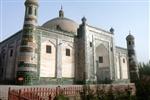
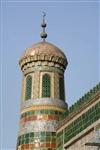
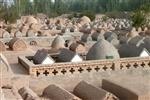

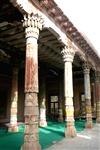
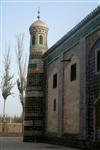
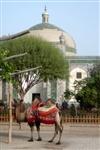
 Copyright © 1998-2025 All rights reserved.
Copyright © 1998-2025 All rights reserved.
1.
Sep 14, 2010 10:44 Reply
OSMAN said:
T Appak huja, now a days only tourists are going there but not local people,
other place graves for the respact of our historical scientist,Like Mahmud Kashighari, who drow the firts map of the world,if you have someone like that you also will respact i am sure.by the time you are visiting there just ask yourself why you did come to that grave who was it?also there are some people are teaching about that history,these places are really borring if some one don`t like history,
You are 100 persent right. no more place tourical areas built there, people all built there house but none of them built touricall construction, because people are not very reach i think...
This your idea is really new to me , you wrote the things very realistically.